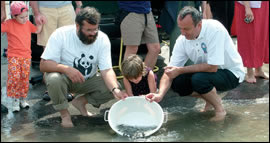 |
Miklos Persanyi, Hungarian Minister
of Environment and Water (right), and Ferenc Markus, Director of WWF
Hungary, release sturgeons, one of the many species of fish native
to the Danube, into the river. |
Events in southern Hungary brought together key government and environmental
officials from Hungary, Serbia and Montenegro, and Croatia for celebrations
that crossed national borders. A Danube Conference at the Lower Danube Valley
Environmental and Water Authority was held in Baja, and an exhibition of
photographs was shown in Mohacs. The central theme of both events was cooperation
between stakeholder groups and across national frontiers.
The Danube Conference brought together representatives of water management,
nature protection agencies and NGOs, as well as other important stakeholder
groups such as the mayors of local communities along the Danube and even
officers of the river police. There were over 50 participants and the event
was covered by national television.
Dr.Rudolf Halász, Director of the Lower Danube Valley Environmental
and Water Management Authority, opened the conference speaking of the very
personal nature of the river. "I am from Baja,” he said, "and
the people of Baja are tied to the Danube by a thousand invisible threads:
the first thing we do every morning is check the level of the Danube and
discuss it with our friends and our neighbours. The river dominates our
lives, just as it influences and controls our beautiful landscape.”
Following his introduction, presentations of water management experts confirmed
the extraordinary rigour and efficiency of Hungarian technical research
and implementation in water management areas such as flood protection, monitoring
changes in the Danube riverbed and wetland restoration in the Gemenc flood-forest.
A river without borders
Boris Erg, nature protection manager of the Gornje Podunavlje Special Nature
Reserve in the Vojvodina province of Serbia and Montenegro, spoke about
what the day’s events mean to the neighbouring protected area in Vojvodina.
"This Danube Day event in Baja was a good idea, important at several
levels. At a national level, it means even more, because it puts Serbia
and Montenegro back in the family of the Danube and Europe,” Erg said.
The importance of cross-border participation was also emphasised by event
organisers. Tamás Enik Anna, NGO nature protection spokesperson and
co-organiser focused on the role of NGOs in that participation. "We
have been able to present the NGO vision of a tripartite, transboundary
protected area, which would unite the neighbouring protected areas in Hungary,
Croatia, and Serbia and Montenegro under an agreed system of common standards
and criteria. I am proud that it is civil society, the international NGO
partnership, which is the driving force of this initiative,” Anna
said.
Combining media and nature
The joy of travelling between Baja and Mohacs is that the shortest route
is across the Danube by ferry, an everyday occurrence for many people living
in this area. In Mohacs, about 80 people came to the Youth Centre for the
opening of an exhibition of photographs by Mario Romulic, an internationally
famous photographer who dedicates much of his time between professional
assignments abroad to capturing the natural glories of Kopacki rit. The
Romulic exhibition was more than a display of photographs. It was a multimedia
experience. Nature films accompanied the photographs, along with a sound
track of birdsongs and ambient, and gave the perception of being deep in
nature. In another room, a dozen computer terminals allowed participants
to explore the fascinating multimedia version of Romulic’s recent
monograph. This event was another excellent illustration of cooperation.
The photographs, originally donated by the WWF-Danube Carpathian Programme
to the Kopacki rit Nature Park, were on loan from Croatia to the DDNP, who
organized the event. The Danube Day events in southern Hungary did much
to bring neighbouring countries together, bridging language and cultural
differences to unite all Danube stakeholders to work together to protect
the river basin.